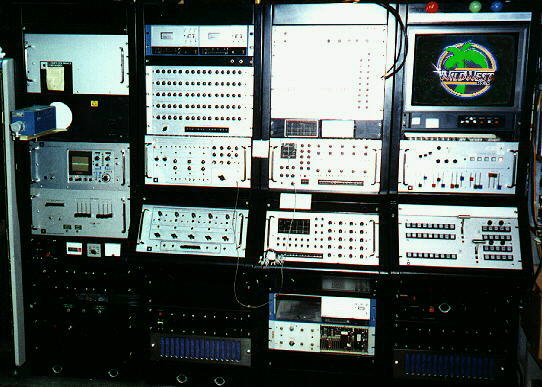<<Previous – Up – Next>>
Analogue graphics computers were the first to be employed for TV and film: their ability to capture and manipulate video images, and their properties of real time manipulation. Though little used for Computer Art per se after the 1960s, the evolutionary line of analogue computers is intriguing precisely because it occurred outside the major computer graphics developments, yet influenced their use and adoption in this area.
Of course, their analogue nature meant that they tackled images in a wholly different way to later digital machines. As Dave Sieg, a Scanimate operator explained, “Instead of typing commands, you wired things together and adjusted knobs… All of the functions producing the scan [on the] CRT were programmable with voltages, and available at various patch panels on the front of the Scanimate.”[1] The “program” was actually a patching together of the variables -- signals from various generators -- which affected the image in real time and animated it. Of course, such effects were hard to duplicate and could result in endless tweaking of parameters.
Like Whitney’s machines, the Scanimate and similar systems began by digitising existing images or artwork; then instead of moving cameras mechanically, they altered the image captured electronically. They had certain “signature” effects, such as distinctive rotation and colour-streaking abilities; and although the interface was extremely complex, it did allow for a high degree of control and significant expert knowledge. Moreover, the machines benefited from their graphics specialisation: this gave them the advantage over general-purpose digital computers. It was only in the mid- to late- Eighties that workstation capabilities matched this real time operation, bringing with them a unified interface and the important factor of reproducibility.
Undoubtedly, had computer graphics technology advanced down a slightly different route, it might have been these machines which would have become the ubiquitous face of computer graphics. But analogue technology was not amenable to the same degree of miniaturisation as digital processors, and the general-purpose nature of the digital computer enabled it to emulate, and then supplant the analogue graphics machines. In this sense they were an sideline in computer graphics, and of only initial interest in Computer Art, but they helped establish both techniques and expectations for graphics.
In many respects, the Scanimate and similar systems were the lineal descendants of Laposky’s oscilloscope and (more directly) John Whitney’s early graphics computers. One of their most important contributions to later digital systems was the conceptual material of image manipulations and special effects that became incorporated into photo and video editing software. Thus digital systems recreated the potentials of their analogue forebears just as they recreated photographic effects and traditional art media.
In another way, however, the analogue systems were important for providing a very different approach to interfaces than that offered by digital systems. Sieg mentions that the Scanimate resembled “some early music synthesizers with their maze of patch cords, function blocks, and knobs”. These knobs and switches controlled specific parameters and, as the machine operated in real-time, could be used to quite subtle effect by skilled operators. They offered a very tactile and physical interface, in contrast to the menus and keyboard short-cuts of most graphical workstations: a highly specialised interface as opposed to a general-purpose one.
[1] Scanimation in the Analog Days, Sieg
This 1973 paper by Alan Kitching, one of the main British pioneers of computer animation, is also very informative


